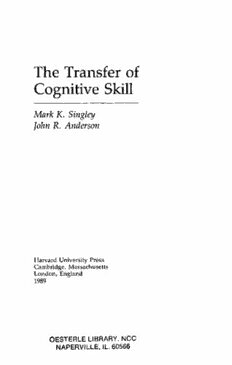
The Transfer of Cognitive Skill PDF
Preview The Transfer of Cognitive Skill
The Transfer of Cognitive Skill Mark K. Singley John R. Anderson Harvard University Press Cambridge, Massachusetts London, England 1989 OESTERLE LIBRARY, NCC NAPERVILLE, IL. 60566 Copyright © 1989 by the President and Fellows of Harvard College All rights reserved Printed in the United States of America 1098 765 43 2 «1 This book is printed on acid-free paper, and its binding materials have been chosen for strength and durability. Library of Congress Cataloging-in-Publication Data Singley, Mark K. The transfer of cognitive skill. (Cognitive science series: 9) Bibliography: p. Includes index. 1. Transfer of training—Case studies. J. Anderson, John R. John Robert), 1947- . IL. Title. III. Series. LB1059.5523 1989 370.15 88-28404 ISBN 0-674-90340-4 (alk. paper) Cognitive Science Series, 9 Cognitive Science Series . Frank C. Keil, Semantic and Conceptual Development: An Ontological Perspective . Edwin Hutchins, Culture and Inference: A Trobriand Case Study William E. Cooper and Jeanne Paccia-Cooper, Syntax and Speech . Edward E. Smith and Douglas L. Medin, Categories and Concepts . John R. Anderson, The Architecture of Cognition . P. N. Johnson-Laird, Mental Models: Towards a Cognitive Science of Language, Inference, and Consciousness Steven Pinker, Language Learnability and Language Development MN Barbara Landau and Lila R. Gleitman, Language and Experience: Evi- dence from the Blind Child . Mark K. Singley and John R. Anderson, The Transfer of Cognitive Skill To our wives, Arlene and Lynne, and our parents, Dorcas and Luther, and Adeline and John Preface hen Singley first came to Carnegie-Mellon in 1982 to study with Anderson, the ACT* theory of skill acquisition was in its final stages of development and the time was ripe for application. What better domain than transfer to test a learning theory, we thought. By taking this approach, we were following a long tradition in which the question ‘What is learned?’ is answered by tests of transfer. We looked first at transfer in text editing and then at transfer in calculus. This book presents the results of that research as well as numerous other theoretical and empirical analyses that are relevant to transfer. As we began to reflect on our work, it became apparent that we were proposing something analogous to Thorndike’s iden- tical elements theory of the transfer process. In short, we as- sumed that transfer was based on those elements that are shared between tasks. In any identical elements theory, the critical question is how to define the elements. Using the ACT” theory as a starting point, we identified production rules as the ele- ments of skill and thus as the basis for transfer. We found production rules well cast in this role by virtue of certain useful properties, notably their independence and abstractness. The theory we present here can be viewed as a resurrection of Thorndike’s theory of identical elements, with production rules and their declarative precursors taking on the role of the ele- ments. With regard to Thorndike, it is possible to ask whether his theoretical glass is half full or half empty. In writing this book, we chose to stress the former (perhaps to get the reader’s blood Vili Preface pumping), casting our theory as a modernization of his. We could just as easily have stressed the many differences between his theory and our own. In fact, our work represents something of a resolution to a conflict that has raged since Thorndike’s day concerning the specificity of transfer. Thorndike proposed an identical elements theory, but because of his lack of a mental representation language, his elements were superficial and tied to overt behavior. In short, Thorndike’s elements made no pro- vision for transfer at an abstract level. With production rules, however, transfer can be localized to specific components (in keeping with Thorndike’s theory) and yet still be quite abstract and mentalistic. We thank the many people who have shared in both the conceptual and the physical preparation of this book. Many of the ideas presented here had their first expression in meetings of the ACT* research group, which has included Frank Boyle, Gary Bradshaw, Fred Conrad, Al Corbett, Rob Farrell, Wayne Gray, Robin Jeffries, Bonnie John, Irv Katz, Claudius Kessler, Ken Koedinger, Matthew Lewis, Jean McKendree, Bob Milson, Peter Pirolli, Lynne Reder, Brian Reiser, Jeff Shrager, and Ross Thompson. Special thanks go to Claudius Kessler and Matthew Lewis, who participated significantly in the research effort and whose work is reported here in some detail. Peter Pirolli and Peter Polson read the entire manuscript and made many insight- ful suggestions regarding content and organization. Kelley George ably managed the physical preparation of the manu- script, including figures and tables. Mari-Jo Dagostino and Judy Rosa provided timely proofreading assistance. At Harvard Uni- versity Press, Michael Aronson encouraged our efforts and helped us define the direction and scope of the work; Virginia LaPlante provided a skillful polishing. Finally, we are grateful for the generous support we received for this work from the Army Research Institute and the Air Force Human Resources Laboratory, Contract MDA903-85-K-0343. Contents 1/ The Study of Transfer 1 2/ Transfer in the ACT* Theory 42 3/ Lateral Transfer 68 4/ Negative Transfer 114 5/ Use Specificity of Procedural Knowledge 138 6/ Simulating Analogical Transfer 163 7/ Declarative Transfer 197 8/ The Theory in Review 222 9/ Representation and Transfer 248 References 277 Index 293
